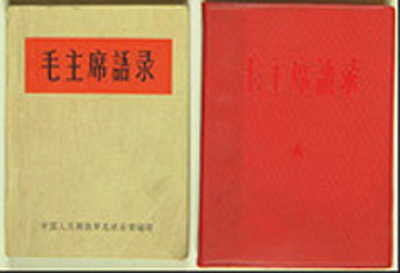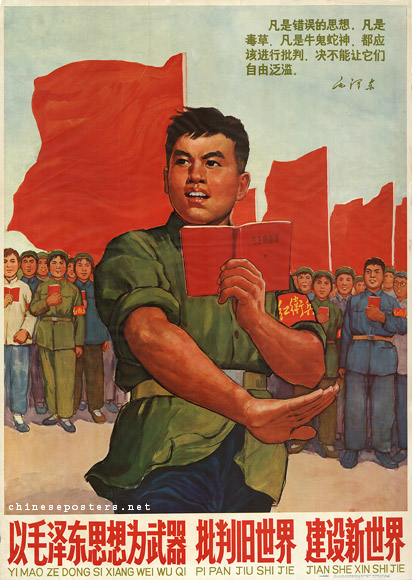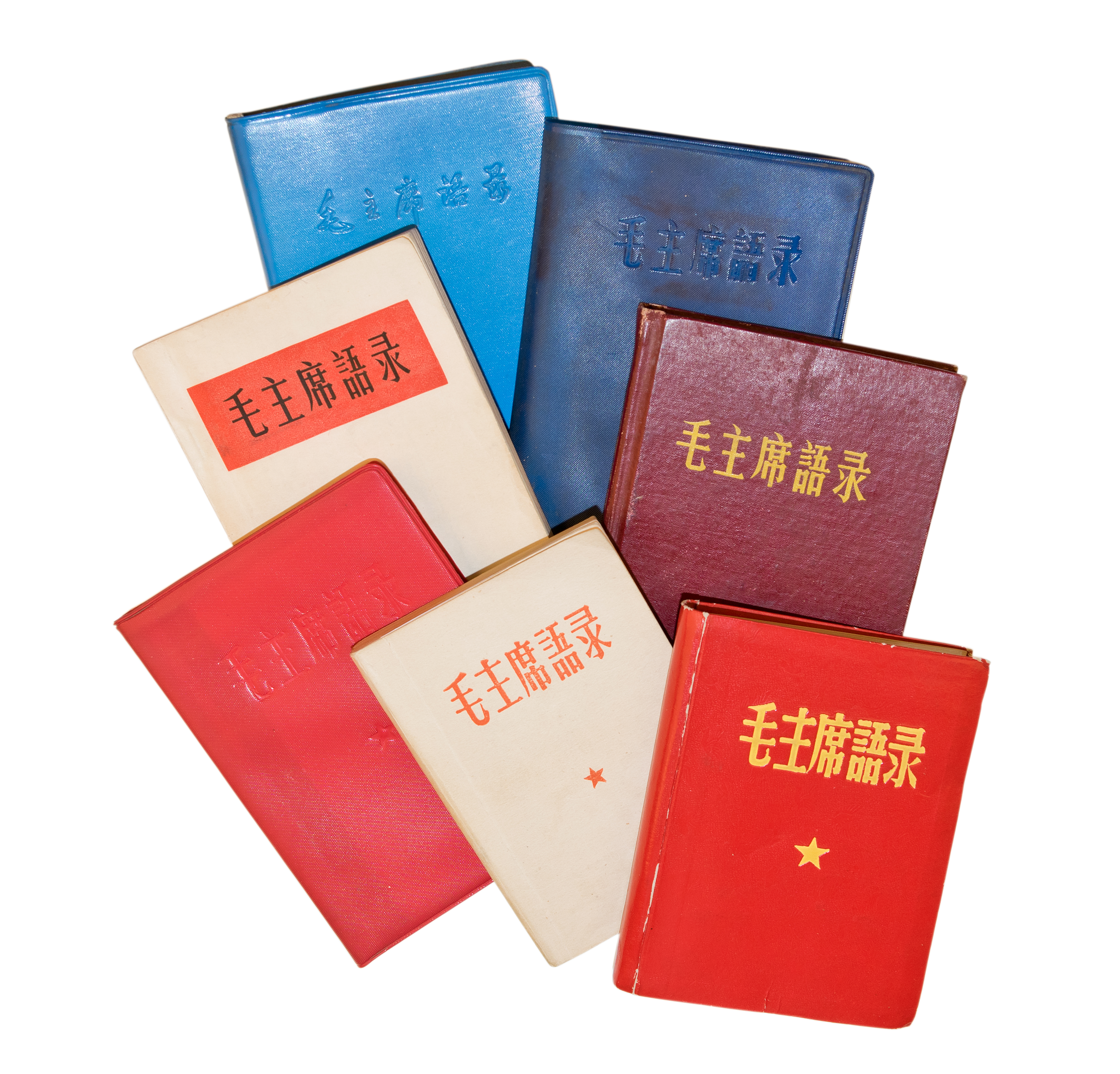 The 1960s was a decade of both discovery and protest, riots and revolutions, from anti-war marches, assassinations of world leaders, man’s first landing on the moon, and the birth of a new brand of music led by The Beatles. Change was in the air and nowhere was it more obvious than in modern China with the outbreak of the Cultural Revolution in August 1966. But more than two years earlier, before Chairman Mao ordered his Red Guards to restructure Society and re-educate intellectuals, there was the "Little Red Book" – a series of useful quotations gathered from Mao’s earlier lectures and writings that would help guide his countrymen and women to deal with problems covering all aspects of daily life. The size of the book was small enough to fit inside a shirt pocket so it could be flush against the heart.
The 1960s was a decade of both discovery and protest, riots and revolutions, from anti-war marches, assassinations of world leaders, man’s first landing on the moon, and the birth of a new brand of music led by The Beatles. Change was in the air and nowhere was it more obvious than in modern China with the outbreak of the Cultural Revolution in August 1966. But more than two years earlier, before Chairman Mao ordered his Red Guards to restructure Society and re-educate intellectuals, there was the "Little Red Book" – a series of useful quotations gathered from Mao’s earlier lectures and writings that would help guide his countrymen and women to deal with problems covering all aspects of daily life. The size of the book was small enough to fit inside a shirt pocket so it could be flush against the heart.
Its phenomenal popularity may be because the book was essentially an unofficial requirement for every Chinese citizen to own, to read, to memorize and to carry copies at all times during the last ten years of Mao's rule, which essentially comprised the Cultural Revolution. Studying the book was not only required in schools but it also became a standard practice in the workplace. All units, in the industrial, commercial, agricultural, civil service, and military sectors, organized group sessions for the entire workforce to study the book during business hours that often extended into evening discussion meetings. During the middle to late 1960s, the book became the single most visible icon representing Mainland China, even more visible than an image of Mao himself. In posters and pictures created by propaganda artists, nearly every painted character whether smiling or looking determined, was always seen with a copy of the book in his or her hand. The glorification of Mao’s quotations gradually evolved into a personality cult that still honors the Chairman to this day and copies of his collected sayings has never been out of print in many of the world’s major languages.

The first edition of Mao’s quotations came out in 1964; it was originally issued in printed paper wrappers intended for the individual use of officers and simultaneously published in the more familiar red vinyl plastic covers which were created for use by brigades of up to eight men at a time, its sturdiness ideal for passing around as well as its use in study discussion groups. Although the book was originally intended for inspirational reading, it became so popular that ultimately within two years it was decided that every Chinese citizen should have a copy: to read, to memorize, and to follow. By the end of 1967 it was estimated that 700 million copies had been printed. Ultimately the book was translated into more than fifty different languages and by the end of the twentieth century it is believed that 5 billion copies had been printed.
 I made my first visit to mainland China in 1998 and at that time one could buy a first edition "Little Red Book" for a few hundred dollars, but the prices have been increasing substantially as demand for the book has increased, mainly from collectors in the Western Hemisphere. A lot depends on the physical condition of the book, how clean it is, and its completeness. The earliest copy that has sold at auction was at Sothebys NY in December, 2002, estimated at $1,500/2,000 and selling for a hammer price of $13,000 in printed paper wrappers. This was an exceptionally clean copy. And as a 1st edition the book only contained 30 chapters with 250 pages. A second edition was issued in March 1965 adding two more chapters (now 260 pages), and finally, a third edition came out in August 1965 with a 33rd chapter, which brought it up to 270 pages, and it is this edition which formed the basis for all future reprints and translations. A more complete summary can be found at the Bibliographical Society of America’s website here.
I made my first visit to mainland China in 1998 and at that time one could buy a first edition "Little Red Book" for a few hundred dollars, but the prices have been increasing substantially as demand for the book has increased, mainly from collectors in the Western Hemisphere. A lot depends on the physical condition of the book, how clean it is, and its completeness. The earliest copy that has sold at auction was at Sothebys NY in December, 2002, estimated at $1,500/2,000 and selling for a hammer price of $13,000 in printed paper wrappers. This was an exceptionally clean copy. And as a 1st edition the book only contained 30 chapters with 250 pages. A second edition was issued in March 1965 adding two more chapters (now 260 pages), and finally, a third edition came out in August 1965 with a 33rd chapter, which brought it up to 270 pages, and it is this edition which formed the basis for all future reprints and translations. A more complete summary can be found at the Bibliographical Society of America’s website here.
Nowadays, complete copies of the edition in printed paper wrappers can sell from $3,000 upwards to $10,000 or more; and those in red vinyl about double that price, chiefly because the red vinyl became iconic and associated with the Cultural Revolution. Both versions were printed simultaneously, and in fact there is a very rare issue found only in the red vinyl edition where a text error occurs at pages 82/83 and gets corrected by an inserted errata slip. When it was revealed in September of 1971 that Lin Biao's family had been planning the assassination of Mao, their plane was shot down over Inner Mongolia and the people were asked to tear out the endorsement leaf by Vice-Chairman Lin which occurred in all "Little Red Books" up to that time, to eradicate his name from modern history. Thus one may find many copies with the calligraphic leaf missing following the portrait of Mao at the front of the book. Even though this was sanctioned by the government, the torn out page greatly reduces the book's value to a collector as one can imagine.
On November 13th, 2014 (through January 10th, 2015) The Grolier Club will be hosting a 50th anniversary exhibition devoted to Quotations of Chairman Mao representing the gradual evolution of the texts from 1951 to 1960, then various prototypes, trial bindings, the book itself as published in 1964 followed by expansions, abridgements, translations and imitations augmented with vintage artifacts, posters, prints, statuary, enamelware, textiles and even an original set of stereotype printing plates for manufacturing the many hundreds and hundreds of editions, including chanting exercises set to music for daily exercise.

Research has also turned up several hitherto unknown prototypes of Mao's Quotations dated from 1960 through 1963, and these will be on display at the Grolier Club for the very first time, along with the original stereotype matrix sheets used for printing the 1966 English language translation of Mao's Quotations. The show will be augmented with various vintage relics showing the propaganda use of the "Little Red Book" in China during Mao’s life (he died in 1976).
Everything is borrowed from my personal collection. The show is free of charge and open to the public weekdays and Saturdays (except for national holidays).



 The 1960s was a decade of both discovery and protest, riots and revolutions, from anti-war marches, assassinations of world leaders, man’s first landing on the moon, and the birth of a new brand of music led by The Beatles. Change was in the air and nowhere was it more obvious than in modern China with the outbreak of the
The 1960s was a decade of both discovery and protest, riots and revolutions, from anti-war marches, assassinations of world leaders, man’s first landing on the moon, and the birth of a new brand of music led by The Beatles. Change was in the air and nowhere was it more obvious than in modern China with the outbreak of the 
 I made my first visit to mainland China in 1998 and at that time one could buy a first edition "Little Red Book" for a few hundred dollars, but the prices have been increasing substantially as demand for the book has increased, mainly from collectors in the Western Hemisphere. A lot depends on the physical condition of the book, how clean it is, and its completeness. The earliest copy that has sold at auction was at Sothebys NY in December, 2002, estimated at $1,500/2,000 and selling for a hammer price of $13,000 in printed paper wrappers. This was an exceptionally clean copy. And as a 1st edition the book only contained 30 chapters with 250 pages. A second edition was issued in March 1965 adding two more chapters (now 260 pages), and finally, a third edition came out in August 1965 with a 33rd chapter, which brought it up to 270 pages, and it is this edition which formed the basis for all future reprints and translations.
I made my first visit to mainland China in 1998 and at that time one could buy a first edition "Little Red Book" for a few hundred dollars, but the prices have been increasing substantially as demand for the book has increased, mainly from collectors in the Western Hemisphere. A lot depends on the physical condition of the book, how clean it is, and its completeness. The earliest copy that has sold at auction was at Sothebys NY in December, 2002, estimated at $1,500/2,000 and selling for a hammer price of $13,000 in printed paper wrappers. This was an exceptionally clean copy. And as a 1st edition the book only contained 30 chapters with 250 pages. A second edition was issued in March 1965 adding two more chapters (now 260 pages), and finally, a third edition came out in August 1965 with a 33rd chapter, which brought it up to 270 pages, and it is this edition which formed the basis for all future reprints and translations. 